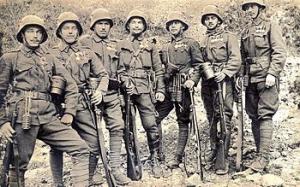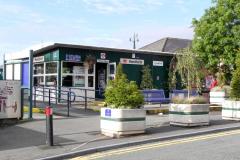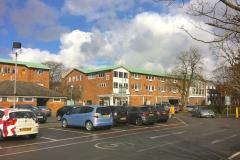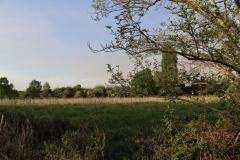
"Operation Michael" the first offensive of 5 of the "Kaiserschlacht" or Kaiser's Battle began without warning at 4.40 on the morning of 21 March. There was a terrifying, orchestrated bombardment of over 6,000 guns on the British front between Cambrai and St Quentin. This, the biggest artillery attack in history to date - over 1,000,000 shells - raked our trenches sideways, forwards and backwards for 5 hours. At 9.45 enemy infantry attacked through a heavy, concealing mist. We were outnumbered by 3 to 1 in many places.
In the north 19 crack German divisions assaulted Byng's 3rd army of 14 divisions over a front of 28 miles - here we just about held on. However in the south, Gough's 5th army of 12 divisions strung unevenly along 42 miles of defences quickly succumbed to the 43 directed against it. Attacked by small groups of well trained and well-equipped "storm troopers" many of our battalions were literally wiped out. Gough seen by some as "unlucky", by others as inefficient had a recently assembled force that was under strength, overstretched, outnumbered and badly deployed in recently acquired French trenches. Short of labour and reserves they had had no time to prepare sound defences.
The German troops advanced this month well over 40 miles in a few days - unheard of since summer 1914. Ninety thousand Allies surrendered. German losses were greater and tellingly, they suffered particularly high casualty rates amongst their irreplaceable elite assault units. They became victims of the rapidity of their success - scurrying far ahead of their artillery and rations. Amazed to find the "relatively lavish" scale of food and drink enjoyed by their opponents, discipline began to break down; they took to looting and gorging. The offensive was finally halted on 5th April just 50 miles from Paris, near Amiens and Villers-Bretonneux where the British and Australians supported by the French held the line.
Nineteen lads from our community perished this month - 10 killed in just 2 days. They are, of course, commemorated in France, Belgium and locally in our many churches, memorials and family graves and are buried, if known, where we indicate.
Of the 19, 4 were from South Oak Lane and, unless indicated otherwise, they were from Wilmslow.
1st - Gunner Frederick PETERS; 10 Lindow Terrace; Royal Marine Artillery; Alderley Edge Cemetery
17th - Lce Cpl E Cyril RICHARDS; St John's Lindow area; 153 Field Co Royal Engineers; Huts Cemetery, Belgium
17th - Lt Stuart BOLTON; St John's Lindow area; 1st/4th King's Own Royal Lancashires; Gorre British and Indian Cemetery
21st - Capt Frank LINDSAY; Wirral Hall, Hall Rd; 3rd King's Shrophire Light Infantry; Quentin Rd Cemetery, Arras
21st - Pte Samuel AUSTIN; South Oak Lane; 2nd/5th Manchesters
21st - Pte James Matthew PUGH; South Oak Lane; 2nd/6th North Staffs
21st - Gunner Percy Edward LEECH; Altrincham Rd; Royal Field Artillery; Royle New British Cemetery
21st - Pte John WORSLEY; West View Terrace, Lacey Green; 223 Machine Gun Co, Royal Marine Div; Abbeville Communal Cemetery Extension
21st - Pte Henry GIBSON; 95 Alma Lane; 9th Cheshires
22nd - Lt Charles Egerton ENTWISTLE; "Riversdale" Hawthorn Grove; 2nd/8th Manchesters; British Cemetery Marchelpot
22nd - Pte Arthur BAILEY; formerly of Bollin Walk; 18th Manchesters
22nd - Pte Archie BRADLEY; formerly of South Oak Lane; 17th Manchesters
22nd - Pte Francies James HEWITT; Green Low Heath, Chelford; 9th Loyal North Lancs; Beaumont-les-Cambrai Military Cemetery
24th - Pte James Rowland MORGAN; 2 Lacey Green Avenue, Lacey Green; 1st/28th London Regiment (Artists' Rifles)
27th - Sapper Frederick FROST; Row of Trees, Mobberley; Royal Engineers; Mont Huon Military Cemetery, Le Treport
28th - Pte Victor Stafford BROUGHTON; 7 Chapel Lane; 1st/7th Manchesters
28th - Pte William PARKINSON; 36 Park Road; 1st/4th Northumberland Fusiliers
28th - Sgt William George WAREHAM; South Oak Lane; 2nd/7th Manchesters; Hangard Communal Cemetery Extension
30th - Guardsman Cyril AINSWORTH; Hawthorn Walk; 2nd Scots Guards; Bucquoy Rd Cemetery
As the dreadful March days moved into April things began to change. The reinforced Allies reorganized and stiffened their resolve. Meanwhile "Operation Michael" was to be stopped and Ludendorff changed his tactics to move north to Flanders. Amiens was saved and the British and French were not irrevocably split. However, casualties on both sides continued to build up horrifically.
Jon Armstrong and Alan Cooper, Wilmslow Historical Society.










Comments
Here's what readers have had to say so far. Why not add your thoughts below.
We owe so much to all our troops who went through this horror and I wonder why we have never learned that wars solve nothing only cause death and despair.